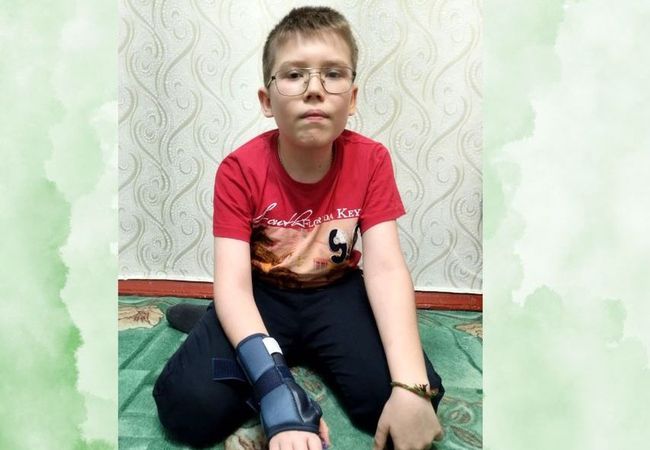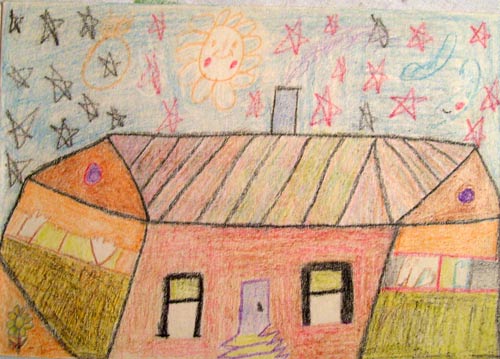
A Painting made by Anton, a ward of the Kalinovka internat (Anton has spent more than 30 years at Kalinovka)
In March of 2007 we visited the Chernigov Children’s Home (at Kalinovka) for the first time, returning from there depressed by the sight of dozens of children confined to bed with serious health issues. Worst of all, we had no notion of how to help these unfortunate ones. Thank God, more and more folks from Ukraine and other countries began to pool their efforts to help the children of Kalinovka. A team of like-minded persons came together. We undertook an independent medical inspection of the most grievously-ill children and were better able to understand what sort of aid was most called for.
The Trip of 29 December 2007
Two days before New Year’s, on 29 December 2007, we once again visited Kalinovka. Taking part this time were the Zaporozhye photojournalist Romashka, Sergei (driver), and the writer of these lines, Albert Pavlov. While visiting a benefit sale of paintings the day before, Romashka, using available funds, put her energies to the task of purchasing gifts for the children. For the sum of around UAH 2100 ($420) we bought ten inflatable rubber animals, brightly-colored books, marbles, and 160 New Year’s sweets.

Romashka - photografer
In just two hours we “flew” from Zaporozhye to Kalinovka. At the very moment our home town was covered with a heavy snow blanket, Kalinovka still had little snow. Driving up to the internat, we decided first to visit the cemetery where the dead children are buried. (Of the severely disabled at the facility, eight to twelve children die annually.) The sight of the cemetery made an indelible impression. During the over eighty-year history of the Kalinovka children’s home, some 400 children have been buried here. Strikingly, only isolated little graves are well kept and have memorial markers. A large area of the ceme¬tery—practically level to the ground—shows only small little mounds, without name plates. Who are these children? Do the parents know where their child’s little mound is located?
Decades ago in our colossal state there were grandiose undertakings—flights into space, weapons race, and the like. Today in independent Ukraine there are also ample big concerns—just around the corner, the Europe Cup in soccer, EVRO-2012. But half a century ago, as now, in our state and society there was not enough money (most likely there was not a lack of money but determination) properly to bury these abandoned little ones, if only to supply a burial stone or iron cross with nameplate. How is it possible to speak of a spiritual rebirth, as long as these suffering children-orphans are being buried like dogs?
We understand that we need to think first of all of the living, but at the same time we should make every effort to give the cemetery at Kalinovka a decent appearance.
Should the governor of Zaporozhye Oblast read these lines, we ask him to attend to this neglected children’s cemetery. It is our belief that in any civilized country such a situation is simply intolerable. Perhaps some religious community will accept the task of providing basic care for the cemetery. Or maybe ordinary citizens will want to help.

The children’s cemetery. In the distant background — the building for the bedridden children and smoke from the boiler








Among four hundred graves only several are well kept like this one
We approach the internat. In front of a small bridge we come to a stop and photograph the building for the bedfast children from a distance. Against the back¬ground of the boiler smokestack, out of which thick black smoke pours (heating is by means of heavy fuel oil), the old building appears surreal. I remember the account of David, an American, whose ancestors, German Mennonites, owned Kalinvoka, which was originally an agricultural estate called “Steinbach.” From 1813 until the revolution in 1917, this estate was one of the wealthiest in the district. I think readers will be interested to see how the building looked 100 years ago and how it looks today.

Steinbach-Kalinovka—beginning of the 1900s

Kalinovka—building for the bedridden children, December 2007
Finally, we are at Kalinovka. Nikolai Viktorovich Slavov, director of the home, meets us graciously. Immediately we busy ourselves with unloading and setting up the dry pool and inflating the rubber animals at the building for the bedfast children. Donors for the dry pool, the large soft bean bag chairs, and office supplies were found thanks to the efforts of Mariana, Tania, Linna from Kiev (all participants in the forum likar.info), and also Anna from Holland. The volunteers also presented a Sony TV, a DVD player, and a VCR. The cost of the dry pool alone was around UAH 5,000 ($1,000); altogether, the gifts that we brought came to a total of more than UAH 10,000. A huge thank-you to all, both donors and volunteers.
As soon as the dry pool was put together, the play room was transformed instantaneously, and virtually nothing in it any longer called to mind a hospital ward. The children, after piling into the pool, reacted cautiously at first, but then began gradually to adjust and play.
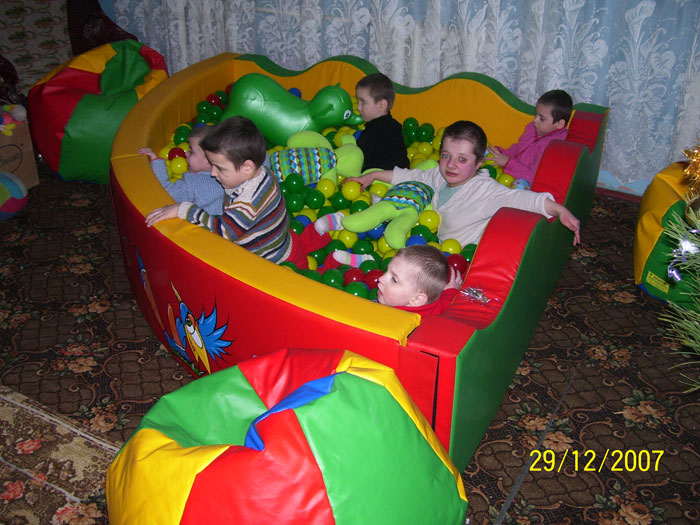


TV, DVD, and VCR donated by the Kiev volunteers
After playing with the children in the dry pool, we headed for the building for boys 4 to 17 years of age. There we decided to try to work with the children—to read books and to interact with a small group. To be sure, we understood perfectly well that only a small number of children would be able to understand even some of what they heard. After all, many of them carried the diagnosis “idiot” (complete lack of speech and thought) or “imbecile” (moderate degree of intellectual underdevelopment). [Translator: note Albert’s irony here in these terms. “Idiot,” “imbecile,” and “moron,” as he knows full well, belong to a dehumanizing nomenclature long since discarded, but still used at Kalinovka. Today one speaks of “mild,” “moderate,” “severe,” or “profound’ cognitive impairment. Even the word “retarded” is avoided.]
Since it did not seem practicable to work with a group of twenty-eight boys all at one time, we chose a separate room and brought in four of the boys who, in our opinion, showed the most promise. One must acknowledge that one senses a huge attention deficit in all of the children. Nonetheless, their reaction to hearing the stories and seeing the pictures was very good. When I varied the intonation, I saw that the boys listened carefully and even quieted down. Given the constant noise of such a group, this was hard to believe. The boys knew virtually nothing about the simplest animals, foxes and bees, for example. They poked at the book with a finger and asked me the names. What pleased them especially was K. Chukovsky’s illustrated story, “Doctor Aibolit.”


A toy car donated by the Kiev volunteers of likar.info

Reading children’s books with the boys. On the extreme left next to Albert is Alyosha Romanov
I was especially impressed with Alyosha Romanov, a teenager of fifteen who must contend with the consequences of cerebral palsy and impaired speech. Already on our first visit to Kalinovka, when I caught sight of Alyosha in the ward for bedridden children, I noticed the look in his eyes. It was not the look of a child with a diagnosis of “idiot,” his classification according to the untrained personnel at the internat. Certainly, Lyosha speaks with great difficulty—but after interacting with him, you understand that this is the result of the CP and not of mental retardation. If you try, it is possible to understand Alyosha. For example, Lyosha suddenly gathered up all the books into a pile (there were twelve of them) and began to count them. I listened and was able to make out his score with some certainty. Alyosha counted all twelve correctly. Then he began to recognize and pick out perfectly many letters from the text. I was amazed! Here is a child who has lived for about ten years in a facility for severely impaired kids, never having the opportunity for rehabilitation, and he is giving me a sign: “I am a person! I am not a vegetable! I can read! I am able to learn something! Help me get out of this situation!
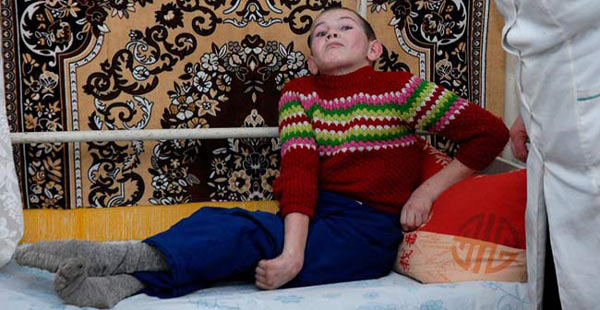
Alyosha Romanov, at the time of our first visit to Kalinovka
I am 100% certain, that this was exactly what Alyosha wished to convey to me in collecting the books and counting them. To my questions about Alyosha, the teacher-aides only threw up their hands: “What to do with him? He can’t even speak!” At the time of our second trip on 22 February we continued work with Alyosha. I am certain that in view of this boy’s longing to learn, it is completely within his power to learn to read and even to type on the computer.
Then we tried a similar tack in the building with the girls. Unfortunately, we had no such success here as we did with the boys. The girls were seated apart, each in her own place; several listened to the stories attentively, but only a pair of them could even point out correctly where the eyes on a teddy bear are.
Having our pictures taken with the girls beside the New Year’s tree for a souvenir, we bade farewell to all and left Kalinovka.

Tanya-Romashka with girls of Kalinovka

A group of girls

“Puffy chairs” from Kiev
Trip to Kalinovka, 20-22 January, 2008
In order to discuss organizational issues that had piled up, to have greater contact with the children, and better to enter into the internal world of the Kalinovka home, we decided to spend several days at Kalinovka. Early in the morning on Sunday, 20 January, we left Zaporozhye. These persons took part in this trip: Kiev volunteer and journalist of the TV station 1 + 1, Mariana Voronovich, Zaporozhye volunteers Ira and Andrei Kotovy, Svetlana Krylova, her son Misha, rehab therapist Sasha and the author of these lines, Albert. Andrei, Ira, Sveta, and Misha spent one day at the internat.
After arriving at Kalinovka, we settled in right away at an auxiliary apartment in the two-story building located on the campus of the children’s home. Several families of workers at the internat reside there and also the present director, Nikolai Viktorovich Slavov. At the time of our arrival, Sasha, the rehabilitation-massage specialist from Zaporozhye, had already been living for a week in this same apart¬ment. For his part, the director, Nikolai Viktorovich, gave us a very warm welcome.
Soon the larger part of our group was playing with the children in the building for the bedridden. Several of the little ones amused themselves in the dry pool, others were running to the adults, desperately begging to be picked up. Little Vera, a girl able to crawl but not to walk, does not especially like to play. Her basic strata¬gem to get into someone’s arms—wrap her little arms around the neck of this person and hold on for dear life! Any attempt to seat Vera on the sofa invariably caused a huge cry to ring out!


Larisa

Yura

Zhenya

Katya
«And there was a wailing and gnashing of teeth…»
While the playroom seethed with interaction, I wandered around the ward for the bedridden children. The feeding had just begun. A few children were lying full and contented, but it was not possible without pain to observe the majority of the little ones. For example, one emaciated Down’s child, completely pale, with blue spots, lay face down, and part of the food that he had tried to swallow was already on the sheets directly next to his mouth. This child lay there, showing practically no signs of life. Another Down’s child sat on the bed, slightly rocking back and forth, wedged to the wall. Suffering was etched on the faces of both children. Nearby lay a girl. I do not know her name, but I remember her still from our first visit to Kalinovka. This girl lies all the time on her side. On this occasion she looked somewhat worse. On her face there were some sort of sores, and her body periodically twitched with cramps. In addition to that, there emanated from her continually a strange and exceedingly loud sound. A moment later it dawned on me: it was a grinding of teeth! There was a fourth child in the room, a little tyke with constantly closed eyes and moving hands, suggesting that he is blind. From time to time (once in five minutes) he cries out weekly and hits himself on the face with his palm. The fifth child: a boy with active glance, but with tiny hands and swollen stomach, shows obvious signs of “exhaustion” (hypotrophy). This child had a frightened look, but at the same time he grabbed my finger with his hand right away. In another room, next to the hydrocephalic children, a girl Nadia is lying. On Nadyusha there is some sort of strange ridge or growth on the back of the head, not allowing her to turn onto her back. During any attempt to raise or to turn over this girl, she appears to feel pain from this crest. Thus she lies on her side all of the time. I saw this girl on our previous trip, but I was afraid to approach her then. This time, however, I made up my mind to hold her hand, and then and there she grabbed onto my hand with her warm little one, smiling slightly. [Translator’s note: Nadia apparently has an encephalocele, a congenital brain hernia in which a portion of the brain protrudes from the back of the head. We think she came to Kalinovka in the fall of 2005, but we do not know if she has been examined by a neurosurgeon.]
All of the children described undoubtedly suffer, and one simply does not have enough emotional strength to take it all in. Certainly, it is gratifying that things in their rooms are changing at least somewhat for the better—glued-on cheerful children’s photo wallpaper, a fixed aquarium with fish, and in two wards—TV and DVD; and there have appeared a lot of toys. But just as earlier, for most of the time, the children are stuck in their own room face to face with their fears and pain. The nurse-aides, as much as they would like to, are not able to devote enough time to these children. To one aide are assigned eighteen children. A doctor comes from the raion center (county seat) at Chernigov once a week and has two hours to devote to 160 children. How then can one not recall the biblical version of hell—a place where there is no love and there is only “crying and gnashing of teeth.”

Nadya



Stories for the Boys
On the following day, 21 January, the first snow fell at Kalinovka. To be sure, it melted then and there. We continued to mingle with the children.
Alyosha Romanov, seated at his customary place next to the radiator and catching sight of me in the doorway, happily flapped his hand and even tried to get up on his feet. Today, again, I am reading stories with the “average” boys. Around me are some five boys, already seasoned listeners. Four listen with interest, but the fifth, Vitaliy, a Down’s child, as usual on his own, is leafing through a book all by himself. He examines the pictures quietly, smiles, and whenever he comes across a small house of any sort, points it out to me without fail and almost dances with delight. “Doctor Aibolit” and “Chattering Fly” enjoy great success with us. In order not to overload the children with information, we arrange for an interlude of physical exercise. The boys, however much they can, repeat every exercise with enjoyment. Even the “crawlers” begin to “run” after a fashion—rapidly moving about with the help of hands or rolling over on the back. After two hours I tell the children, “Do cvidania” and leave the room, my head “crosswise” from the noise and emotion. But I am very satisfied.
During this time Mariana was busy with making necklaces and sketching and coloring with a group of girls, and Sasha, our rehab expert, was giving massage in the room for the “lying-in-bed” children.
There at the Bridge
Yesterday we promised a group of young women to take a walk with them to the internat’s fringes. Unfortunately, the weather after lunch had turned sharply worse: a wet snow fell, turning into showers. But we decided not to break our promise. In a storage area we looked for one of the wheelchairs sent from Germany with Oleg Gerashchenko, assembled it, and pumped up the tires. Into this wheelchair we seated Ira, the oldest of the residents of the children’s group. During our stroll, and disregarding the pelting of the wet snow on her face, Ira little by little told us her story.
Ira has already lived at Kalinovka for thirty-two years, from the age of four. She wound up here after being transferred from a “baby house.” Ira has problems with her feet, and she spends most of her time in a small wooden wheelchair. This was the first time that she was making use of a chair in which she could actually sit, and it suited her very well—her feet do not hurt as much as in the old chair, and to move around was quite interesting. In fact, she used to be constantly afraid of falling from the old chair. In the winter season of the year Ira practically never goes outdoors. And in summer she does not go further than several meters from the summer pavilion.
“Ira, do you like it here at Kalinovka?”
Ira thought for a moment and answered: “I am really tired; I often find this constant noise tiring.”
She means the cluster of thirty girls, four- to thirty-six-years old, who surround her constantly.
“I would like to go somewhere else.”
“And where would you like to go?”
“. . . I don’t know, somewhere . . .” Ira became sad.
By this time we had crossed over the small, ancient bridge located 200 meters north of the internat. Ira observed that it was the first time during her thirty-two years of living at Kalinovka that she had gone past this bridge!

The bridge built by the German-Mennonites who lived here until the revolution
In order to warm ourselves up, we stopped by at the cattle barn belonging to the internat. There a work group of ten male residents works on a regular basis (the so-called “youth unit”). The girls took a photo together with Mariana against the backdrop of the cattle, but Ira was afraid to go into the barn:
“Ugh! They are so disgusting and dreadful, those cows!” So, she remained at the entrance to the barn to await us.
Returning to the girls’ building, we took a photo of ourselves as a souvenir of our excursion. Everyone was wet and on the verge of freezing, but all were satisfied with our walk. Ira, after all, for the first time in thirty-two years, had gone over the bridge that she can see from her window every day.
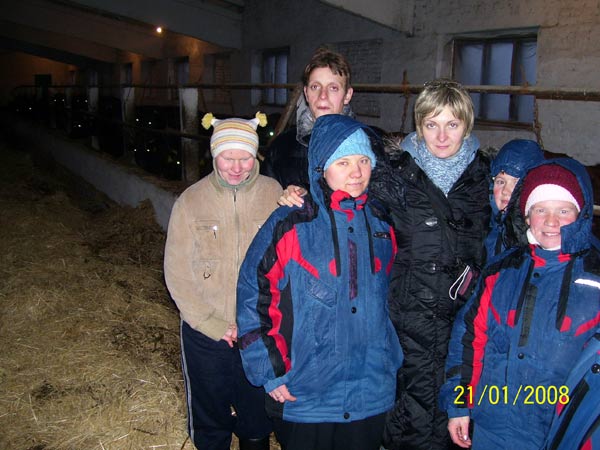
Excursion to the cattle barn

Ira

After the excursion

Friends Julia and Ira

Ira in her new wheelchair

Mariana V. (on cell) doing lessons with the young women

Sveta copied for us the inscriptions from the audiocassettes

Monster with long snout is present practically on all of Sveta’s pictures
«The Youth Unit»
Of the 156 residents of the internat, forty-six are eighteen to thirty-eight years old. These men live in a separate building. Some ten of them are extremely well adjusted to life, able to look after themselves, perform simple jobs on the farm, and even receive wages. The informal leader of this young men’s unit is Anton, who has lived at Kalinovka since the age of four, already more than thirty years. Chatting with Anton and his friend Sasha, I did not cease to be amazed at their good sense, so rare for a place such as this internat. Anton spoke unhurriedly, with confidence, and his words held meaning. In the apartment where he and three other pairs live there is a music center, TV and DVD, and Anton has a cell telephone, as well. On the wall hangs a cross with an image of Christ, and above Anton’s bed, a small icon. One of the fellows found the cross in a rundown home in a nearby village, and gave the icon to Anton. He has never been in a church, and at Kalinovka there is virtually no interest in religious confessions. (At any rate, over the last few years no one has been interested.) The nearest Orthodox church is located forty kilometers away. It is remarkable, but Anton prays each day after dinner. They tell him that there is no God, but he believes in God anyway.
Anton and several of his friends love to draw. Anton’s drawings are very colorful and in some respects unusual. All of his houses are mysteriously curved, with high chimneys and windows without sills. Perhaps psychologists can find some meaning in these drawings.
I wondered: where does this wisdom come from that Anton and several of the guys manifest, since they have spent their entire lives at Kalinovka? Perhaps they caught the eye of some one of the aides, who, growing fond of the boys, began to give greater attention to their development? And perhaps they simply had a lighter degree of impairment and wound up at Kalinovka by chance?
The other fellows of the “youth unit” have a more serious level of psycho-neurological impairment. They spend a great part of the time in one room, seated on long benches and watching a television that is suspended from the ceiling. It cannot be easy for the two nurses’ aides to control such a crowd; sometimes it is necessary to call on Anton for help. I observed the evening “outing” to the dining hall of these fellows. It is not a spectacle for those with weak nerves! All of them, faces frightened, run out of the building—one in shoes, one in slippers, and one fellow in just socks . . . And under driving winter rain they run through the puddles. It seems that all of this is happening on a different planet! . . .

Anton and Sasha

In Anton’s apartment

“House,” a colored drawing by Anton
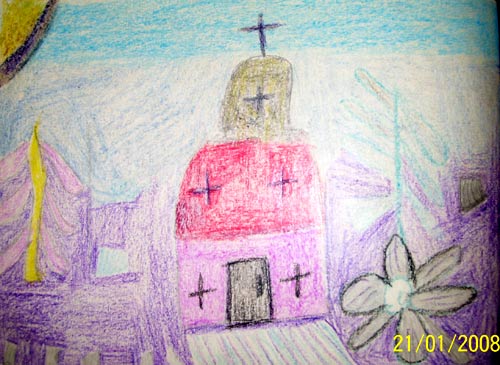
"Church," a colored drawing by Anton
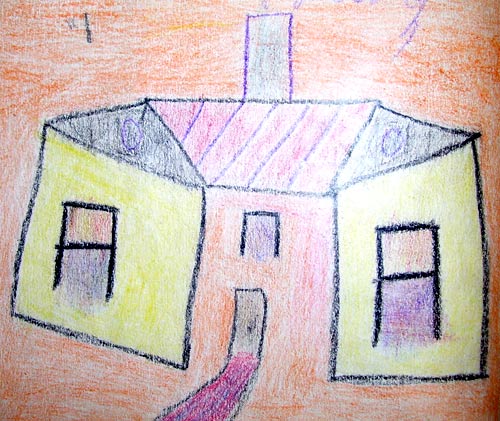
“House 2,” a colored drawing by Anton

A colored drawing by Anton

The apartment of the older boys with equipment recently purchased through state funds: a ping-pong table and two training machines
A Conversation with the Director over Tea
Toward evening, the director of the internat, Nikolai Viktorovich Slavov dropped in for a visit. Casha, the rehab therapist, Mariana, and I seized the opportunity presented by this pleasant and informal occasion to raise with the director all of our accumulated questions and ways to deal with them.
Nikolai Viktorovich brought us heartening news: apparently beginning on 1 February 2008 the staff of the internat will be taking on ten new aides in the building for the bedridden children. This means that two aides will be added to each shift, and the workload for one person will consist of ten children instead of eighteen. To the staff roster they will also add one teacher, one person for social activities, and six persons for the farm.
We, the volunteers of the website www.deti.zp.ua and associates of the charitable organization Schastlivii Rebyonok (Happy Child), are providing additional funding for the work of two teacher-aides. One of them will work in the building for bedridden children and will mentor a group of five children. The other teacher will work in the building for the boys. There we are planning to divide the large group of twenty-eight children into two groups. In one group will be children whose development can and must be furthered (tentatively there would be ten to twelve boys). In the other group will remain children who have an extremely severe degree of impairment to the nervous system and require mainly medical care.
Judging by the director’s account and everything we observed, the state investment in the Kalinovka facility is growing steadily. In May they plan a capital improvement of the building for the bedridden children (cost approximately UAH 450,000), equipping the cleaned-up buildings, etc. We chose that moment to express our deep concern over the distressing condition of the children:
• Signs of substantial financial investments at Kalinovka on the part of the state government do not always mean real improvement in the care of the children.
• Medical care, as before, does not stand up to criticism. A doctor at the internat is lacking: a doctor comes out from Chernigov only one time a week for two hours. As a result, the death rate of the children at the internat is very high (eight to twelve children per year), whereas at similar facilities in Ukraine it is far lower.
• The children have practically no medical checkups and they often receive inappropriate or inadequate medical treatment, or lack any treatment at all.
• The bedridden children never go outdoors, perhaps for years! “Crawlers” get out into the fresh air only during the warm times of the year.
• Rehabilitation measures are lacking.
• Several of the seriously ill children require special rations and diet, other¬wise they face a death sentence.
• Standards of hygiene for the care of the children are often inadequate or not observed. (Two pampers per day per child are obviously not sufficient; many children spend hours in overfilled diapers.)
• Overflowing groups of children, lacking options for engaging in small-group activities—these conditions weigh down and depress the psyche, even for those residents who have the capacity for learning or training.
• The children’s cemetery: the appearance of the burial place of the children is intolerable in a civilized country.
It is important to give credit to Nikolai Viktorovich: he accepted all of the above-mentioned points as constructive criticism and intends to change the situation for the better. He acknowledged the existence of these problems and explained why, up to now, they have not been resolved. For example, until now the internat did not have the wherewithal to buy disposable diapers in the necessary volume. (There is a similar problem at the baby home “Solnychko” in Zaporozhye.) Hundreds of thousands of hryvnia are allocated to capital improvements. But when it comes to diapers, our state has not been prepared to loosen up the purse strings. And it is the same situation with the overfilled groups: there are not enough nurse-aides and teacher-aides on staff. In theory, there exists the position of “staff doctor” at the internat but it is vacant—not a single doctor wants to go to such an out-of-the-way place. The nurse-aides do not have the physical means to carry the children outside for a walk, and so on. As a result we arranged with the director to decide jointly the whole complex of problems that have piled up at this internat over many years.
Nikolai Viktorovich recognizes that when Happy Child volunteers came on the scene, life at the internat became better. Earlier everything here went along quietly and routinely, but now various visitors show up regularly, journalists, and the like. Personnel are beginning to work in a more friendly way, and little sparks of hope are appearing in the eyes of the children.
We are appealing to the oblast authorities to devote greater attention to the children’s home at Kalinovka. This does not mean allocating fabulous sums of money. In fact, after adding only UAH 7000 ($1400) to the monthly budget for the purchase of pampers, we will solve the problem of the dreadful odor in the ward for the bedridden children and get rid of many skin infections among the children.
If we allocate a salary and a place to live for a doctor, we will be able to save the lives of several children each year and relieve the suffering of dozens more. By adding ten staff members, teachers and aides, (UAH 12,000 per month or $2,400), we will be able to provide the children not only baseline care but also definite possi¬bilities for individual development. Is it possible to regard an oblast budget of UAH 30,000 per month ($6,000) for these abandoned children as a great waste?
Conclusion
We spent only two days at the internat, but it seemed an eternity. A two-hour ride from Kalinovka and we are in the city with its thousands of automobiles and people . . . An altogether different world, entirely and utterly unknown to Ira, Anton, Alyosha, Nadia, and dozens of other residents of Kalinovka. But we will remember these children and return to them in the near future. Hopefully, next time we will arrive with a large group of sympathetic persons prepared to give their love and attention to these children. And with each passing day we will notice on the faces of the children less and less suffering.
Those wishing to take part in a visit to Kalinovka on a day off, or also to help with transportation (delivery of volunteers, donated items to Kalinovka) please call +3 8 066 513 34 35 (Albert), detizp@mail.ru
How to make contributions for the children of the internat at Kalinovka
(For donors in the United States who wish to make a charitable donation that is tax-deductible, please e-mail dsudermann [at] charter.net for more information.)



